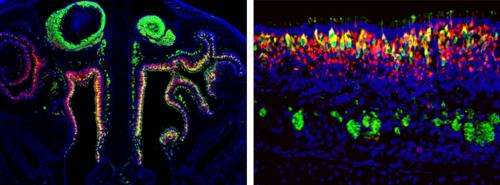A protein in neurons in the nose controls the sensitivity of mice to smells in their environment

Information about odorant molecules in the environment helps animals to find food, select mates and avoid predators. Yoshihiro Yoshihara and colleagues from the RIKEN Brain Science Institute have now identified a protein called Goofy within sensory neurons in the noses of mice that helps to sharpen their sense of smell.
Goofy is expressed in the olfactory epithelium (Fig. 1), the inner surface of the nose where odors are initially detected by receptors on olfactory sensory neurons. Yoshihara and his colleagues homed in on this particular protein because it contains a motif called a signal peptide, which is also found on many other transmembrane and secreted proteins known to have important functions in regulating the sense of smell.
In mice genetically engineered to lack Goofy, the researchers observed that the neurons in the olfactory system maintained their normal connections with each other, suggesting that Goofy does not play a role in controlling the formation of the olfactory neural circuitry. However, they found that adenylyl cyclase III—a key enzyme involved in olfactory signaling in olfactory sensory neurons—was mislocalized in Goofy-deficient mice. This indicates that Goofy is required for correct trafficking of this protein. "It is likely that the proper localization of these molecules is crucial for the normal functioning of sensory systems," says Yoshihara.
Olfactory neurons contain long membranous extensions called cilia that stretch into mucus in the nose to detect odorant chemicals. Goofy-deficient mice had shorter olfactory cilia compared to normal mice, suggesting that Goofy regulates the development of cilia in olfactory neurons. Additionally, the researchers found that olfactory epithelium cells from Goofy-deficient mice produced weaker electrical responses than normal cells when exposed to various odorants. Goofy-deficient mice also exhibited less fear behavior compared to normal mice when exposed to an odor from foxes—one of their natural predators. According to the researchers, these findings show that Goofy is required for mice to maintain their keen sensitivity to odorant information in their environment.
"A fully functioning olfactory system is important for our health and increases our quality of life," Yoshihara says. "Because the human genome also contains the Goofy gene, which is most likely expressed in our nose, the present findings may have important implications for human disorders of olfactory perception, including anosmia—the loss of the sense of smell," he explains.
More information: Kaneko-Goto, T., et al. Goofy coordinates the acuity of olfactory signaling, The Journal of Neuroscience 33, 12987–12996 (2013). dx.doi.org/10.1523/JNEUROSCI.4948-12.2013

















